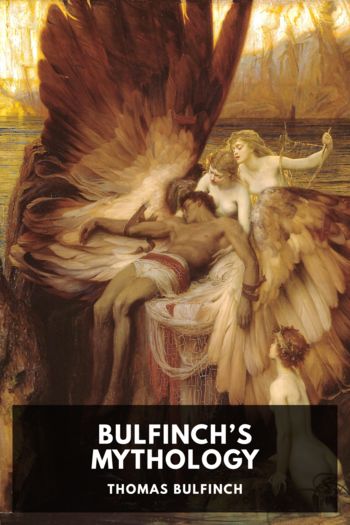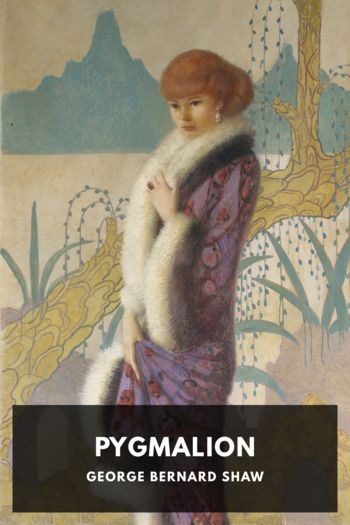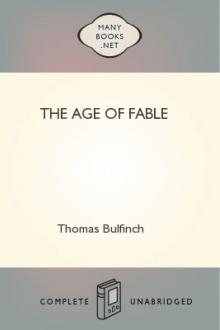Bulfinch’s Mythology, Thomas Bulfinch [love story books to read txt] 📗

- Author: Thomas Bulfinch
Book online «Bulfinch’s Mythology, Thomas Bulfinch [love story books to read txt] 📗». Author Thomas Bulfinch
The ceremonies of initiation were peculiarly solemn. After undergoing a severe fast, and spending whole nights in prayer, the candidate confessed, and received the sacrament. He then clothed himself in snow-white garments, and repaired to the church, or the hall, where the ceremony was to take place, bearing a knightly sword suspended from his neck, which the officiating priest took and blessed, and then returned to him. The candidate then, with folded arms, knelt before the presiding knight, who, after some questions about his motives and purposes in requesting admission, administered to him the oaths, and granted his request. Some of the knights present, sometimes even ladies and damsels, handed to him in succession the spurs, the coat of mail, the hauberk, the armlet and gauntlet, and lastly he girded on the sword. He then knelt again before the president, who, rising from his seat, gave him the “accolade,” which consisted of three strokes, with the flat of a sword, on the shoulder or neck of the candidate, accompanied by the words: “In the name of God, of St. Michael, and St. George, I make thee a knight; be valiant, courteous, and loyal!” Then he received his helmet, his shield, and spear; and thus the investiture ended.
Freemen, Villains, Serfs, and ClerksThe other classes of which society was composed were, first, freemen, owners of small portions of land independent, though they sometimes voluntarily became the vassals of their more opulent neighbors, whose power was necessary for their protection. The other two classes, which were much the most numerous, were either serfs or villains, both of which were slaves.
The serfs were in the lowest state of slavery. All the fruits of their labor belonged to the master whose land they tilled, and by whom they were fed and clothed.
The villains were less degraded. Their situation seems to have resembled that of the Russian peasants at this day. Like the serfs, they were attached to the soil, and were transferred with it by purchase; but they paid only a fixed rent to the landlord, and had a right to dispose of any surplus that might arise from their industry.
The term “clerk” was of very extensive import. It comprehended, originally, such persons only as belonged to the clergy, or clerical order, among whom, however, might be found a multitude of married persons, artisans or others. But in process of time a much wider rule was established; everyone that could read being accounted a clerk or clericus, and allowed the “benefit of clergy,” that is, exemption from capital and some other forms of punishment, in case of crime.
TournamentsThe splendid pageant of a tournament between knights, its gaudy accessories and trappings, and its chivalrous regulations, originated in France. Tournaments were repeatedly condemned by the Church, probably on account of the quarrels they led to, and the often fatal results. The “joust,” or “just,” was different from the tournament. In these, knights fought with their lances, and their object was to unhorse their antagonists; while the tournaments were intended for a display of skill and address in evolutions, and with various weapons, and greater courtesy was observed in the regulations. By these it was forbidden to wound the horse, or to use the point of the sword, or to strike a knight after he had raised his vizor, or unlaced his helmet. The ladies encouraged their knights in these exercises; they bestowed prizes, and the conqueror’s feats were the theme of romance and song. The stands overlooking the ground, of course, were varied in the shapes of towers, terraces, galleries, and pensile gardens, magnificently decorated with tapestry, pavilions, and banners. Every combatant proclaimed the name of the lady whose servant d’amour he was. He was wont to look up to the stand, and strengthen his courage by the sight of the bright eyes that were raining their influence on him from above. The knights also carried favors, consisting of scarfs, veils, sleeves, bracelets, clasps—in short, some piece of female habiliment—attached to their helmets, shields, or armor. If, during the combat, any of these appendages were dropped or lost the fair donor would at times send her knight new ones, especially if pleased with his exertions.
Mail ArmorMail armor, of which the hauberk is a species, and which derived its name from maille, a French word for mesh, was of two kinds, plate or scale mail, and chain mail. It was originally used for the protection of the body only, reaching no lower than the knees. It was shaped like





Comments (0)